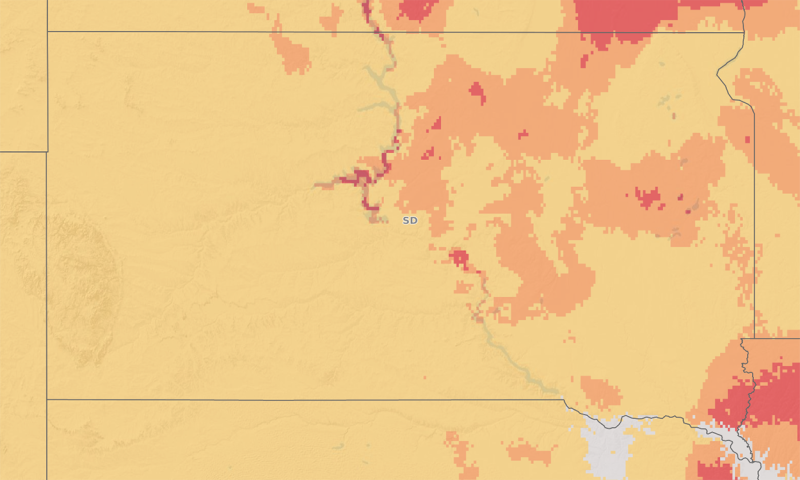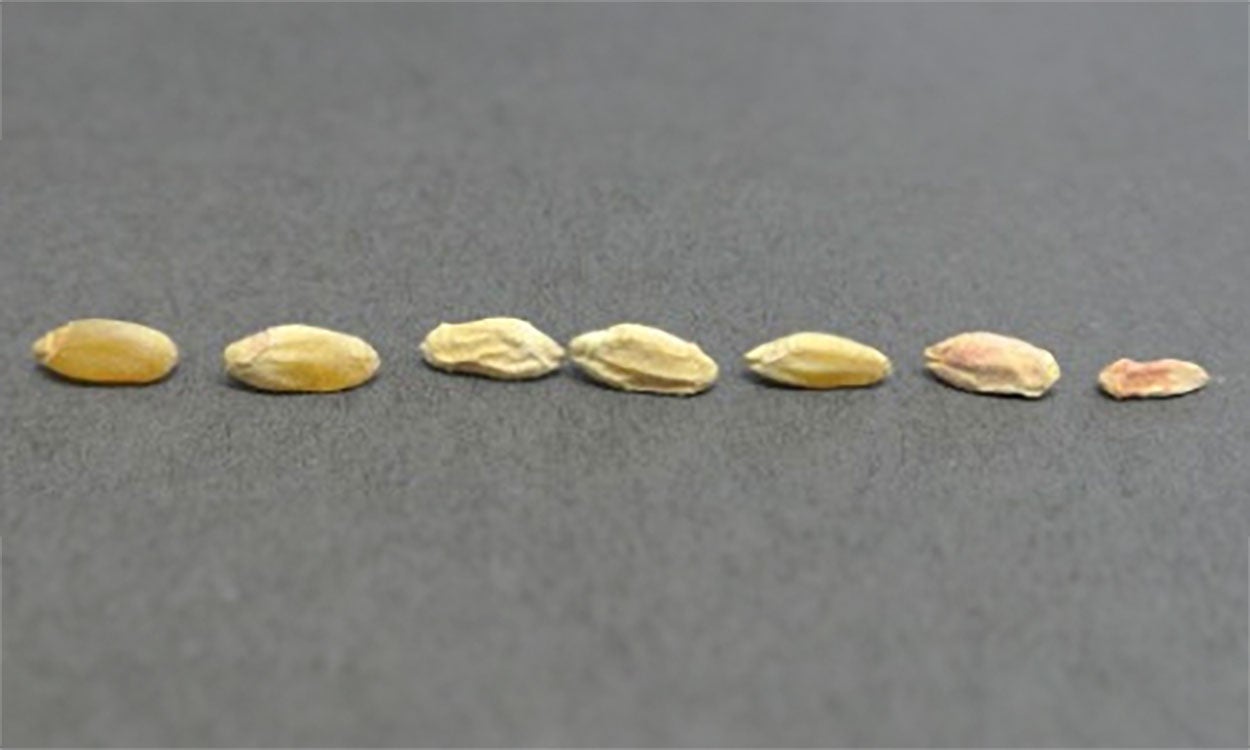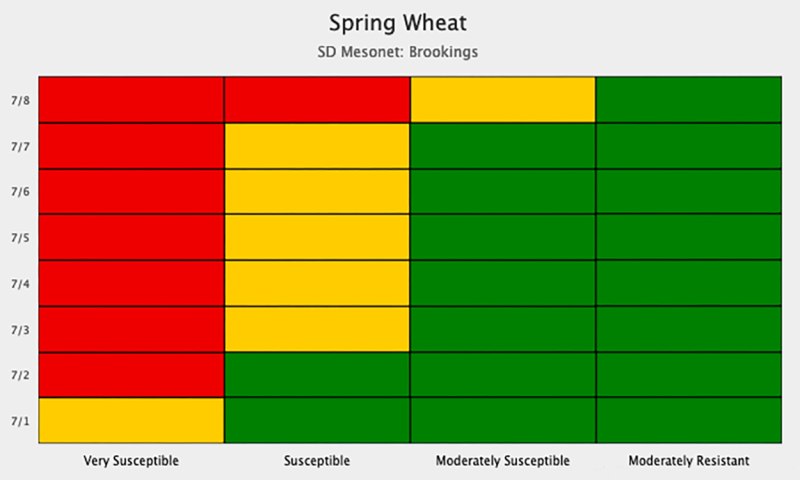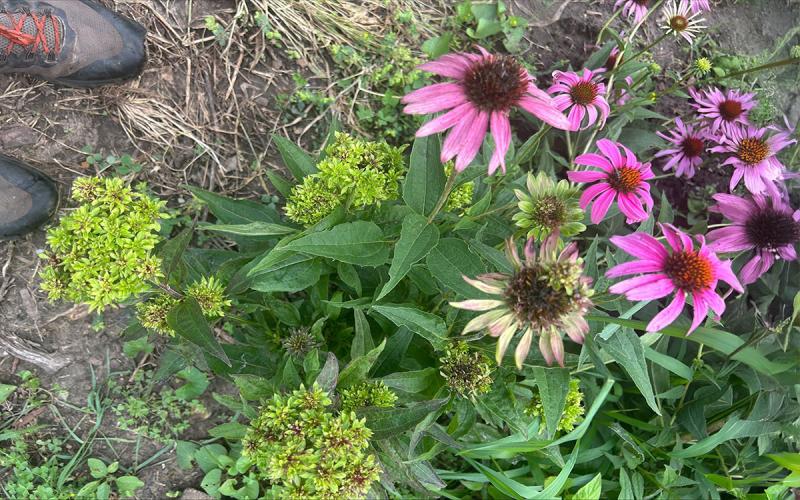Written collaboratively by Sierra Mesman, Tasneem Fathima, and Madalyn Shires.
Introduction
Fusarium head blight (abbreviated as FHB), also known as Scab, is an economically important fungal disease that adversely affects the yield and quality of wheat through mycotoxin contamination. The warm and humid conditions prevalent in South Dakota throughout June 2024 have significantly favored FHB disease development. As of this week, the risk for FHB in spring wheat has begun to increase. Predicted areas having medium and high risk of scab are in spring wheat growing areas (Figure 1).

As spring wheat is beginning to flower in the state, a timely fungicide application may be necessary to protect yields. Additionally, an understanding of FHB, along with appropriate management techniques, will help in effectively managing the disease outbreak thereby improving crop yield.
What is fusarium head blight?
FHB is caused by more than seventeen species of Fusarium. Fusarium graminearum (also known as Gibberella zeae) is the most-predominant species. The most-common symptom of FHB is premature bleaching of one or more Infected spikelets or the entire immature wheat head. The bleaching can start anywhere on the head and spread until the entire head is bleached (Figure 2).
During humid conditions, white or pink fungal growth with orange spore masses may be seen on the base of infected glumes or spikelet, a visual sign of the disease. Sexual blue-black fruiting structures also can form, giving the head a scabbed appearance, hence the name scab.
Infected kernels become chalky, shriveled, and turn white to light-pink and are often referred to as “tombstones” (Figure 3). These tombstone kernels are heavily contaminated with mycotoxins and blown away with the chaff at harvesting.


Disease Cycle
The FHB disease cycle begins with the fungus overwintering on infected crop residues. With the onset of favorable conditions (warm, wet, humid weather), infection begins at the flowering stage, especially during anthesis. When the spores dispersed by wind and rain reach the anthers, the spores germinate. The fungus grows into the developing kernels and can continue to infect other kernels in the head. The infected kernels begin to shrivel and remain under-developed.
Disease Management
FHB and mycotoxin accumulation can be limited through integrated disease management practices using resistant varieties alongside good agricultural practices for mitigating the effects of FHB.
Resistance
Several moderately resistant varieties of wheat are available for farmers to plant. Refer to the latest Spring Wheat Variety Trial Results to see the ratings for specific varieties.
Cultural Practices
The fungus responsible for causing FHB has a wide host range of small grain cereals and other and grass crops, such as corn. For this reason, farmers should avoid planting wheat right after cereal crops. Risk of infection increases if the field is infected with Gibberella stalk and ear rots. To avoid infection spread from previous crop stubble, farmers are encouraged to have longer rotations between small grain and corn crops to promote residue decomposition. Infected seeds should not be planted without using a fungicide seed treatment.
Fungicides
Triazoles are the most-effective fungicides for FHB management. Fungicides cannot eliminate the fungus completely, instead the infection can be minimized up to 70%. The fungicides Miravis Ace, Caramba, Proline, Prosaro, Prosaro Pro, and Sphaerex are recommended against FHB.
- The North Central Regional Committee on Management of Small Grain Diseases (NCERA 184) has enlisted a table of fungicides and the efficacy of each fungicide to control various wheat disease.
For application, the high-volume application capability of large ground sprayers (>90-foot boom width) is effective for spraying the fungicides using the recommended front and back-end nozzles. During wet conditions, aerial application is considered, the efficacy of which can be improved by increasing the volume of application to a recommended four to five gallons per acre.
Harvest
An adjusted combine can be used to remove infected kernels and reduce the number of damaged kernels. Infected fields should be harvested separately, and grains should not be mixed with grains from other fields.
Postharvest
FHB-infected kernels must be stored properly to reduce further impact to grain quality. Grain should be cooled and dried before storage. For short-term storage, grain should be cooled to below 50 degrees Fahrenheit (10 degrees Celsius) and dried to below 15% moisture. Grain stored long term should have a moisture below 13%. Molded grain should be evaluated for mycotoxin content before use.
Conclusion
Fusarium head blight is a fungal disease that needs to be scouted and monitored during the 2024 spring wheat cropping season. The development and spread of FHB in wheat is favored by warm, humid, and wet conditions. FHB-specific risk estimation for a particular location can be obtained through SD Mesonet Small Grains Tool (Figure 4).

Control of FHB is possible by employing various disease management strategies. A combination of different methods, such as proper preparation of the soil for cultivation; crop rotation (along with the use of catch crops); selection of cultivars with a high level of resistance; alongside fungicide application and post-harvest methods, like proper storage and ozonation, may provide effective results.
References and Resources
- An Overview of Fusarium Head Blight, Crop Protection Network.
- Managing Fusarium Head Blight At Harvest, Manitoba Government.
- Dealing With Fusarium Head Blight, Manitoba Government.
- Fusarium head blight (FHB) or scab, The American Phytopathological Society (APS).
- A Farmer’s Guide to Wheat Diseases, The American Phytopathological Society (APS).
- Control of Fusarium Head Blight (or Scab) in Wheat, University of Missouri Extension.
- Spring Wheat Variety Trial Results, SDSU Extension.
- Small Grains Disease Tool, Mesonet at SDState.
- Fusarium Risk Tool, Fusarium Head Blight Prediction Center.
- Fusarium Head Blight Management, University of Nebraska-Lincoln Extension.

